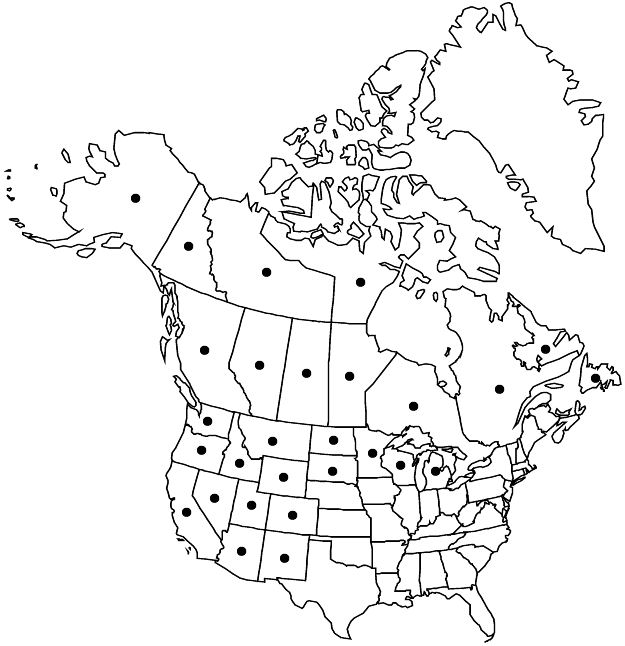Parnassia palustris
Sp. Pl. 1: 273. 1753.
Herbs with caudices. Stems 8–35 (–50) cm. Leaves: basal in rosettes; petiole 2–10 cm; blade (of larger leaves) ovate to suborbiculate, 6–40 × 4–30 mm, base rounded to cordate, apex rounded; cauline usually on proximal 1/2 of stem, rarely on distal 1/2. Flowers: sepals spreading or ± reflexed in fruit, linear to narrowly lanceolate, 4–11 mm, margins not hyaline, entire, apex subacute; petals 5–11-veined, obovate, (7–) 8–17 (–20) × 5–12 mm, length 1.5–2 times sepals, base rounded, margins entire; stamens 6–8 mm; anthers 1.5–2.8 mm; staminodes obovate, divided distally into (7–) 9–27 gland-tipped filaments, 5–9 mm, ca. as long as stamens, apical glands suborbicular to ovoid, 0.2–0.5 mm; ovary green. Capsules (6–) 8–10 mm. 2n = 18, 36.
Phenology: Flowering summer.
Habitat: Seasonally wet meadows, fens, thickets, ditches, shores, rocky or gravelly seashores, wet rocks.
Elevation: 0–3800 m.
Distribution

Alta., B.C., Man., Nfld. and Labr., N.W.T., Nunavut, Ont., Que., Sask., Yukon, Alaska, Ariz., Calif., Colo., Idaho, Mich., Minn., Mont., Nev., N.Mex., N.Dak., Oreg., S.Dak., Utah, Wash., Wis., Wyo., Eurasia, nw Africa, temperate and subarctic regions
Discussion
The North American populations of Parnassia palustris have been treated as subsp. neogaea, which has petals usually with five to nine veins and staminodes tapering proximally. Most European populations of var. palustris have petals with 10 to 17 veins and staminodes abruptly clawed proximally. Populations from northern Europe and from some of the mountains of central Europe often have petals and staminodes similar to those of var. neogaea. European authors have sometimes treated those populations as subsp. obtusiflora (Ruprecht) D. A. Webb, but there is no general agreement on how the variation in this species should be treated.
Chromosome numbers in Eurasia have been reported as 2n = 17, 18, 27, 32–37, 43–45, 54. Attempts to correlate morphology with differences in chromosome number have been unsuccessful except for slight differences in pollen diameter and seed length (U.-M. Hultgård 1987; R. J. Gornall and J. E. Wentworth 1993). As noted by Gu C. Z. and Hultgård (2001), Parnassia palustris shows much variation in stem height; basal leaf shape and size; cauline leaf position, shape, and size; sepal and petal shape, size, and venation; and number and length of staminode filaments through much of Eurasia, making it very difficult to subdivide it into consistently distinct taxa over the total range. This diversity in Eurasia is paralleled in North America.
Within North America several variants have sometimes been recognized and even treated as distinct species. Variety californica (Parnassia californica) has the cauline leaf in the distal half of the stem, and most populations in California and southern Oregon display this feature, but such plants rarely occur elsewhere in North America and some populations in eastern California have the cauline leaf in the proximal half of the stem. Populations in the Rocky Mountains and some adjacent ranges are sometimes recognized as P. montanensis, which has petals 7–9 × 5–7 mm and staminodes with seven to ten filaments. These are somewhat intermediate between P. palustris and P. parviflora, and it has been suggested that they may be of hybrid origin, although a similar variant occurs in northern Asia in the absence of P. parviflora. It is unclear whether all Parnassia from Arizona are P. parviflora or whether some are this small-flowered variant of P. palustris.
Selected References
None.
